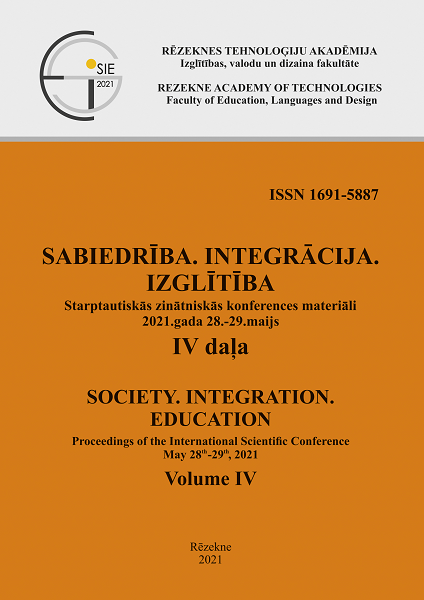VIOLENCE RISK ASSESSMENT IN PSYCHIATRY - LITERATURE REVIEW AND PRACTICE COMPARISON BETWEEN LATVIA AND GERMANY
DOI:
https://doi.org/10.17770/sie2021vol4.6386Keywords:
Forensic psychiatry, standardized tools, violence risk assessmentAbstract
Evidence-based future community violence risk assessment is a crucial issue in psychiatry. It is a cornerstone of safeguarding the rights of persons with mental health issues. Authors aimed to analyse the modern methods of risk assessment in psychiatry and the current practice and legal framework. Authors undertook a scoped review of the literature with search terms related to future community violence risk prediction for mentally disordered offenders in Latvian, English, German, and Russian languages. Main difficulties in future community violence risk assessment are demonstrated via Latvia’s court decisions analysis. Marked differences were identified: there are no standardized methods available/registered in Latvia, therefore risks assessment is performed via clinical assessment only. In Germany, the risk assessment is performed via structured evidence – based risk assessment tools and clinical assessment; nevertheless, the choice of the assessment tool remains challenging.
References
Ārstniecībā izmantojamo medicīnisko tehnoloģiju datu bāze. (n.d.). Pieejams www.zva.gov.lv/zvais/mtdb/
Augstākās Tiesas nolēmuma fragments. (n.d.). Augstākās Tiesas nolēmuma fragments lietā SKK-0258-15, publiski nav pieejams.
Augstākās Tiesas spriedums. (n.d.). Augstākās Tiesas spriedums lietā SKK-0256-15, publiski nav pieejams.
Augstākās tiesas tiesu prakses apkopojums. (2011/2012). Tiesu prakse kriminālprocesā, nosakot medicīniska rakstura piespiedu līdzekļus, Rīga, 45 lpp.
Boetticher, A., Kröber, H.L., Müller-Isberner, R., Böhm, K., Müller-Metz, R., & Wolf, T. (2007). Mindestanforderungen für Prognosegutachten. Forensische Psychiatrie, Psychologie, Kriminologie, 1, 90-100. DOI: https://doi.org/10.1007/s11757-007-0017-9
Buchanan, A., Binder, R., Norko, M., & Swartz, M. (2012). Psychiatric Violence Risk Assessment. Am J Psychiatry, 169(3). DOI: https://doi.org/10.1176/appi.ajp.2012.169.3.340
Dahle, KP., Schneider, V., & Ziethen, F. (2007). Standardisierte instrumente zur Kriminalprognose. Forens Psychiatr Psychol Kriminol, 1, 15–26 DOI: https://doi.org/10.1007/s11757-006-0004-6
Dittmann, V. (2000). Was kann die Kriminalprognose heute leisten? In: Bauhofer SB, Bolle P-H, Dittmann V (Hrsg), Gemeingefährliche Straftäter. Rüegger, Zürich, S 67-95.
Göppinger, H. (1980). Kriminologie. 4. Auflage, Seite 336. München: C.H.Beck.
Hachtel, H., Vogel, T., & Graf, M. (2019). Überarbeitung des Basler Kriterienkatalogs zur Beurteilung der Legalprognose („Dittmann-Liste“). Forens Psychiatr Psychol Kriminol, 13, 73–80. DOI: https://doi.org/10.1007/s11757-018-0477-0
Kolmakov, P. (2017). O nekotoryh problemnih situacijah pravovogo gosudarstvennogo regulirovanija prinuditeljnih mer medicinskogo haraktera. Vestnik Udmurtskogo universiteta. Serija “Ekonomika I parvo”, vol. 27, no. 2, pp. 103-108. Retrieved from https://journals.udsu.ru/econ-law/article/view/1227
König, A., Elsner, K., Schalast, N., & Leygraf, N. (2018). Qualität der Prognosegutachten (gem. § 16 Abs. 3 MRVG NRW und § 463 StPO) bei nach § 63 StGB untergebrachten Maßregelvollzugspatientinnen und patienten in NRW. Abschlussbericht. Düsseldorf. Retrieved from https://www.uni-due.de/imperia/md/content/rke-forensik/material/bericht_prognosegutachten_mrv_nrw_2018.pdf
Kriminālprocesa likums. (2005). 608.pants, Medicīniska rakstura piespiedu līdzekļu atcelšanas vai grozīšanas kārtība, 11.05.2005. Latvijas Vēstnesis, Nr 74. Pieejams https://www.vestnesis.lv/ta/id/107820.
Kröber, H.L. (2008). Kann man die akute Gefährlichkeit schizophren Erkrankter erkennen? Forensische Psychiatrie, Psychologie, Kriminologie, 2,128–136. Retrieved from https://www.springermedizin.de/kann-man-die-akute-gefaehrlichkeit-schizophren-erkrankter-erkenn/9051388
Kuri, H. (2007). Kriminologicheskoe prognozirovanie v otnoshenii seksualnih i drugih opasnih prestupnikov. Opyt Germanii.Kriminologija: Vchera, segodnja, zavtra, N2 (17). Retrieved from https://criminologyclub.ru/PDF/17/17_3.pdf
Landschaftsverband Rheinland. (2008). LVR-Dezernat Klinikverbund und Heilpädagogische Hilfen Fachbereich Maßregelvollzug. Grundsätze für Lockerungsentscheidungen in Maßregelvollzugseinrichtungen. Rechtliche Bestimmungen im Maßregelvollzug. Retrieved from https://www.lvr.de/media/wwwlvrde/klinikhph/maregelvollzug/dokumente_139/rechtlichebestimmungenaktualisierung_08_2010_internetver.pdf
Large, M., & Nielssen, O. (2017). The limitations and future of violence risk assessment. World psychiatry: official journal of the World Psychiatric Association, 16(1), 25–26, DOI: https://doi.org/10.1002/wps.20394
Maßregelvollzugsgesetz. (1999). [MRVG], § 18, 15.06.1999. Retrieved from https://recht.nrw.de/lmi/owa/br_text_anzeigen?v_id=5320110406183667013 Aplūkots 13.02.2021.
Nadelhoffer, T., Bibas, S., Grafton, S., Kiehl, K. A., Mansfield, A., Sinnott-Armstrong, W., & Gazzaniga, M. (2012). Neuroprediction, Violence, and the Law: Setting the Stage. Neuroethics, 5(1), 67–99. Retrieved from https://link.springer.com/article/10.1007%2Fs12152-010-9095-z
Nazarenko, G. V. (2008). Pravovaja priroda prinuditeljnih mer medicinskogo haraktera. Vestnik Omskogo universiteta. Serija “Pravo”, no. 4, pp. 130-134. Retrieved from https://cyberleninka.ru/article/n/pravovaya-priroda-prinuditelnyh-mer-meditsinskogo-haraktera/viewer
Parry, J. (2009). Criminal Mental Health and Disability Law, Evidence and Testimony: A Comprehensive Reference Manual for Lawyers, Judges, and Criminal Justice Professionals, American Bar Association, 462, p. 366.
Polubinskaja, S., & Makushkina, O. (2016). Prognoz riska opasnyh dejstvij lic s psihicheskimi rasstrojstvami: zarubezhnyj opyt i rossijskie perspektivy. Social'naja i klinicheskaja psihiatrija, 26 (3), 96-100. Retrieved from https://www.researchgate.net/publication/308032608_prognoz_riska_opasnyh_dejstvij_lic_s_psihiceskimi_rasstrojstvami_zarubeznyj_opyt_i_rossijskie_perspektivy_violence_risk_prediction_in_persons_with_mental_disorders_foreign_experience_and_russian_persp
Rīgas apgabaltiesas Krimināllietu tiesu kolēģija. (2013). Spriedums Latvijas Republikas vārdā. Lietas Nr 11310081809, Lietas arhīva Nr KA04-0850-13/27. Rīga. Pieejams: www.tiesas.lv%2Fnolemumi%2Fpdf%2F138534.pdf&usg=AOvVaw0Dh04-PTV2IkKEFv_JSrwh
Rowlands, M. T., Palk, G., & Young, R. M. (2017). Psychological and Legal Aspects of Dangerous Sex Offenders: A Review of the Literature. Psychiatry, psychology, and law: an interdisciplinary journal of the Australian and New Zealand Association of Psychiatry, Psychology and Law, 24(6), 812–824. DOI: 10.1080/13218719.2017.1315763
Salize, H.J., & Dressing, H. (2005). Placement and Treatment of Mentally Ill Offenders – Legislation and Practice in EU Member States, Central Institute of Mental Health, Mannheim. Retrieved from http://www.krim.dk/undersider/straffuldbyrdelse/forvaring/psykisk-afvigende-indsatte-placering-europa-eu2006.pdf
Strafgesetzbuch (1871). [StGB] jeb Vācijas Krimināllikums. (15.05.1871). Pēdējie grozījumi 21.12.2020. Pieejams https://www.gesetze-im-internet.de/stgb/BJNR001270871.html Aplūkots 13.02.2021
Strafprozeßordnung (1950). [StPO] jeb Vācijas Krimināla procesa likums (12.09.1950). Pēdējie grozījumi 21.12.2020. Pieejams https://www.gesetze-im-internet.de/stpo/BJNR006290950.html Aplūkots 13.02.2021
The European Court of Human Rights. (2016). (Fifth Section). Case of Klinkenbuss v. Germany, Application no. 53157/11. Retrieved from https://jurisprudencia.mpd.gov.ar/Jurisprudencia/Klinkenbuss%20v.%20Alemania.pdf
Tortora, L., Meynen, G., Bijlsma, J., Tronci, E., & Ferracuti, S. (2020). Neuroprediction and A.I. in Forensic Psychiatry and Criminal Justice: A Neurolaw Perspective. Frontiers in psychology, 11, 220. DOI: https://doi.org/10.3389/fpsyg.2020.00220






